“Did You Hear Me?”
Does it bother you when people do not respond to your communication? When they just look at you, or act as if you said nothing?
On the other hand, do you want people to confide in you? To value their time with you? To regard you as a good conversationist?
If so, you will like this simple, yet powerful, communication technique.
After someone tells you something, what should you do next?
“Acknowledgment: Something said or done to inform another that his statement or action has been noted, understood and received. ‘Very good,’ ‘Okay,’ and other such phrases are intended to inform another who has spoken or acted that his statement or action has been accepted.”
“Acknowledgment itself does not necessarily imply an approval or disapproval or any other thing beyond the knowledge that an action or statement has been observed and is received.” — L. Ron Hubbard
For example, I ask, “What time is it?”
You reply, “It’s nine o’clock.”
I then ignore you.
How would you know I received your answer if I didn’t give you an acknowledgment? You might feel a little confused and wonder why I didn’t say anything.
If I then say, “thanks,” you know I heard you and you can move on.
How to Give a Good Acknowledgment
1. Pay attention, listen and wait until the person is finished.
2. Indicate you received and understood the message. “Okay,” “Thanks,” “Good,” “All right,” “I got that,” “Makes sense,” “Sure thing,” “Fine” and so on. A hand gesture or emoji can also act as an acknowledgment.
Eight Acknowledgment Facts
1. Some people do not like to talk. Why? Perhaps at some point, they tried to express themselves and were repeatedly ignored. They have given up the idea that anyone listens to them.
2. Other people talk too much. Why? They believe no one hears them. They are still trying to get through. They think that if they talk long enough, someone will listen. If someone would acknowledge them, they could relax.
3. When employers give their staff members a good acknowledgment for completing their work, the staff members feel proud and satisfied.
“Boss, I finished that project ahead of schedule and under budget!”
“Good!”
If the boss does not acknowledge the project completion, the employee either repeats the statement or gives up and loses interest in taking on future projects.
4. Employees who are not acknowledged will demand more pay because pay is a form of acknowledgment.
5. Managers and parents need to be acknowledged as well. If you do not acknowledge them, they can get quite angry.
“Could you clean up this area before you leave?”
Silence.
“I said, clean up this area before you leave.”
Blank face.
“DIDN’T YOU HEAR ME? I SAID CLEAN UP THE AREA BEFORE YOU LEAVE! GOT IT?”
If you always acknowledge your boss, he or she feels satisfied and can then move on to other duties.
6. Acknowledgments help keep your relationships going. If you forget to thank people for their gifts, you eventually get no gifts. If you never return calls, you ruin peoples’ moods.
Acknowledging an e-mail or a text is also important. If you do not, senders wonder if their messages got through or if you suddenly dislike them. You improve your relationships when you acknowledge them: “Thanks.”
7. Children who are not acknowledged get upset and demand more attention. “Mommy? Watch this! Mommy? Watch me! Mommy? Look at me! Mommy? Mommy?” Parents who acknowledge their children have calmer, more confident children.
8. If you feel the urge to repeat yourself, speak louder or get angry, check if someone has failed to acknowledge you. Just realizing that the other person has been thoughtless can make you feel better so you can move on.
How to Test this Success Tip
If you are not sure an acknowledgment is important, listen to someone talk to you and then say nothing. Remain silent. Don’t even nod your head. Notice how they react.
Then give the person some relief and say, “Oh, sorry. Yes, I heard you.”
If you do not acknowledge people, you will not be successful. If you do acknowledge people, they will appreciate and support you.
Give it a try!
Check out this free online communication course.
